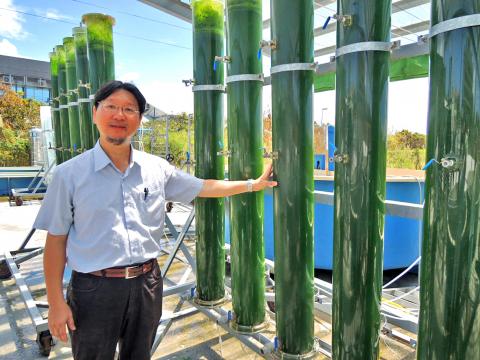An inter-university research team has developed a microalgae-based carbon capture technology and established the nation’s largest pilot microalgae farm at a university in Tainan in hopes of helping the nation conserve energy and reduce its carbon emissions.
Microalgae are the most productive organism for capturing carbon because of their high photosynthetic rate, said the team, headed by National Cheng Kung University professor Chang Chia-hsiu (張嘉修).
The goal of the team was to use the exhaust emissions and wastewater from factories to breed microalgae, which were first mutated from wild algae with special chemical formulas until they were capable of tolerating the level of heat emitted by factory chimneys, and use the bred microalgae to capture carbon dioxide for photosynthesis, the team said.

Photo: Tang Chia-ling, Taipei Times
“We hope to create a sustainable ecological system,” Chang said.
The team discovered that 1kg of microalgae is capable of absorbing 2kg of carbon dioxide, adding that the Chlorella and cyanobacteria often found in Taiwan’s rivers were most effective, Chang said.
If factories could dedicate one hectare of land for the breeding of microalgae, that one hectare would be able to capture 400 tonnes of carbon dioxide per year, he said.
The team has established a breeding center for microalgae at the university’s campus in Annan (安南), Tainan, that is capable of holding 40 tonnes of microalgae, Chang said, with plans for building a bigger center that can breed 200 tonnes of microalgae.
The team has also developed the technology for extracting lutein, synthesizing succinic acid, synthesizing 2-Hydroxypropanoic acid and extracting biodiesel from microalgae, Chang said.
In addition, it has developed a process for breeding microalgae with rhodotorula rubra, Chang said.
Aside from producing biodiesel, rhodotorula can be made into healthcare products, the team said, adding that the carbon dioxide produced when it is growing can also be used by microalgae.
The inter-university team was commissioned by the Ministry of Science and Technology and also includes professors from National Sun Yat-sen University, Tunghai University, Fooyin University and National Chiao Tung University, as well as the Metal Industries Research & Development Center.

Trips for more than 100,000 international and domestic air travelers could be disrupted as China launches a military exercise around Taiwan today, Taiwan’s Civil Aviation Administration (CAA) said yesterday. The exercise could affect nearly 900 flights scheduled to enter the Taipei Flight Information Region (FIR) during the exercise window, it added. A notice issued by the Chinese Civil Aviation Administration showed there would be seven temporary zones around the Taiwan Strait which would be used for live-fire exercises, lasting from 8am to 6pm today. All aircraft are prohibited from entering during exercise, it says. Taipei FIR has 14 international air routes and

The Ministry of National Defense (MND) today released images of the military tracking China’s People's Liberation Army (PLA) movements during the latest round of Chinese drills around Taiwan. The PLA began "Justice Mission 2025" drills today, carrying out live-fire drills, simulated strikes on land and maritime targets, and exercises to blockade the nation's main ports. The exercises are to continue tomorrow, with the PLA announcing sea and air space restrictions for five zones around Taiwan for 10 hours starting from 8:30am. The ministry today released images showing a Chinese J-16 fighter jet tracked by a F-16V Block 20 jet and the

City buses in Taipei and New Taipei City, as well as the Taipei MRT, would on Saturday begin accepting QR code payments from five electronic payment providers, the Taipei Department of Transportation said yesterday. The new option would allow passengers to use the “transportation QR code” feature from EasyWallet, iPass Money, iCash Pay, Jkopay or PXPay Plus. Passengers should open their preferred electronic payment app, select the “transportation code” — not the regular payment code — unlock it, and scan the code at ticket readers or gates, General Planning Division Director-General Liu Kuo-chu (劉國著) said. People should move through the

Snow fell on Yushan (Jade Mountain, 玉山) yesterday morning as a continental cold air mass sent temperatures below freezing on Taiwan’s tallest peak, the Central Weather Administration (CWA) said. Snowflakes were seen on Yushan’s north peak from 6:28am to 6:38am, but they did not fully cover the ground and no accumulation was recorded, the CWA said. As of 7:42am, the lowest temperature recorded across Taiwan was minus-5.5°C at Yushan’s Fengkou observatory and minus-4.7°C at the Yushan observatory, CWA data showed. On Hehuanshan (合歡山) in Nantou County, a low of 1.3°C was recorded at 6:39pm, when ice pellets fell at Songsyue Lodge (松雪樓), a